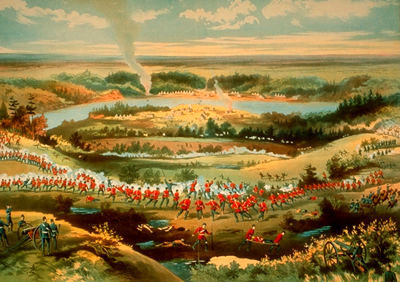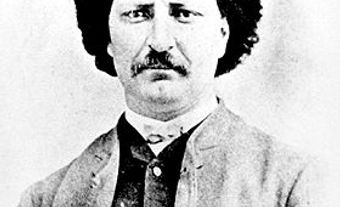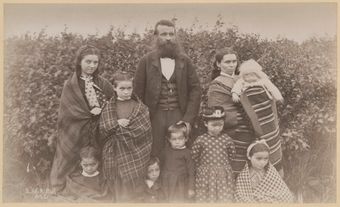The Battle of Batoche, 9–12 May 1885, was the last major action of the North-West Resistance. Under the leadership of Louis Riel, Métis and their First Nations allies were defeated by government troops.

Historical Background
The Red River Resistance of 1869–70, also led by Louis Riel, resulted in the creation of the province of Manitoba. Métis in the province faced hostility from non-Indigenous peoples because of their role in the resistance. They were also dispossessed of their territory. Much of the land promised to the Métis by the government never materialized. (See also Métis Scrip in Canada.) Many Métis moved farther west into present-day Saskatchewan and Alberta.
By the late 1870s, both the western First Nations and the Métis were suffering. Roles for Métis fur traders were disappearing as were the bison on the plains. (See also Plains Indigenous Peoples in Canada.) The signing of treaties made way for towns, farms and railways on lands once claimed by Indigenous peoples. (See also Numbered Treaties .)
The Métis asked Riel to return from exile in the United States in 1884 to press their cause. When he came back, the Métis passed a Revolutionary Bill of Rights on 8 March 1885, which proclaimed their right of possession of their farms among other demands. The Métis proclaimed a provisional government on 19 March 1885 with its capital at Batoche and Riel as president. On 25 March, the federal government ordered the mobilization of the militia. Government forces reached Qu’Appelle, in today’s Saskatchewan, by 10 April.
Opposing Forces
The total strength of Riel’s forces was 300 to 400 Métis and fewer than 1,000 of their First Nations allies, who were spread across the West and preferred to stay on their own lands. Riel’s military commander was renowned Métis hunter and tactician Gabriel Dumont. Government forces consisted of almost 3,000 soldiers transported from the East, supplemented by about 1,700 recruited in the West, plus some 500 North-West Mounted Police. The commander of the North West Field Force was Major-General Frederick Middleton, a British infantry officer who was General Officer Commanding the Canadian Militia.
Middleton’s Strategy
Middleton’s original plan was to march from Qu’Appelle with 900 soldiers to the South Saskatchewan River. Simultaneously, a 400-man column under Lieutenant-Colonel William Otter would march from Swift Current and meet Middleton at the river. The two columns would then move downriver to attack Batoche and deal Riel a knockout blow. Once Batoche was taken, the two forces would put down any remaining rebels.
Before Middleton could implement his plan, he ordered Otter to proceed to the police post at Fort Battleford to protect settlers who had taken refuge there. Middleton departed from Qu’Appelle on 6 April. When he reached the South Saskatchewan, he divided his force to move down both sides of the river toward Batoche.
Middleton commanded the east-bank column. It consisted of A Battery, Royal School of Artillery; a detachment of regulars from Toronto’s C Company, Infantry School Corps; Winnipeg’s 90th Rifles and Boulton’s Mounted Corps. It was joined later by Ontario’s composite Midland Battalion, an improvised mounted intelligence unit of 50 land surveyors and a Gatling gun (an early machine gun). The west-bank column was commanded by an artillery officer and consisted of the Winnipeg Field Battery, Toronto’s 10th Royal Grenadiers and French’s Scouts.
Fish Creek
Dumont set up an ambush with some 150 men about 20 kilometres south of Batoche at Fish Creek, known to the Métis as Tourond’s Coulee. When Middleton’s scouts approached early on 24 April, a skirmish followed. The Métis fired from well-concealed positions in the creek bottom at Middleton’s soldiers, who had to expose themselves on the skyline to fire into the coulee.
The soldiers tried repeatedly to drive the Métis from the coulee, but failed each time. The situation became deadlocked. The troops on the east bank crossed the river and, as the day ended, Middleton and Dumont simultaneously broke off the engagement. Middleton reported 10 killed and 40 wounded, to the Métis 11 killed and 18 wounded. Both sides claimed victory.
The skirmish had shaken Middleton’s confidence. He resolved not to advance until he consolidated his force and received additional supplies. The arrival of the paddlewheeler Northcote on 5 May became part of Middleton’s plan. Manned with 35 soldiers and fortified with thick wood planks and sacks of grain, it was to steam past Batoche and attack from behind in concert with the main attack.
Batoche
On 7 May, Middleton left Fish Creek and arrived nine kilometres from Batoche the next day. The attack began on 9 May, but did not go well. As the Northcote steamed toward the village too early, the ferry cable strung across the river toppled its mast, spars and smokestacks, causing it to drift hopelessly downstream. Middleton also found the Métis were in well-concealed rifle pits with good fields of fire.
As Middleton did not want to risk his inexperienced troops in a frontal assault, unsuccessful daylight forays, supported by artillery 9-pounders and the Gatling gun, followed for the next three days. On 12 May, Middleton attempted a coordinated attack, which also failed. As he sat down to lunch, two militia commanding officers took matters into their own hands and led their battalions forward. The defenders fell back in a running fight and the soldiers overran Batoche. It was in their hands by nightfall at a cost of eight dead and 46 wounded. Middleton claimed the Métis lost 51 killed and 173 wounded.
The capture of Batoche effectively ended the uprising. The provisional government collapsed, Riel surrendered on 15 May and Dumont fled to Montana.
Assessment
Middleton won the Battle of Batoche by greater numerical strength and firepower. Although his strategy was sound, his movements were ponderous and marked by excessive deliberation and hesitancy. He did not consult with his subordinates or share his plans with them until the last minute and he lacked confidence in his militia soldiers. Middleton relied excessively on his infantry and did not use his most-experienced cavalry when the terrain favoured it.
For his part, Riel refused to allow Dumont to use the superior mounted mobility of the Métis to harass Middleton’s column each night as it camped on the prairie. Dumont also relied too much on a static defence using rifle pits. Although it had proven successful previously, it did not work at Batoche.

 Share on Facebook
Share on Facebook Share on X
Share on X Share by Email
Share by Email Share on Google Classroom
Share on Google Classroom










